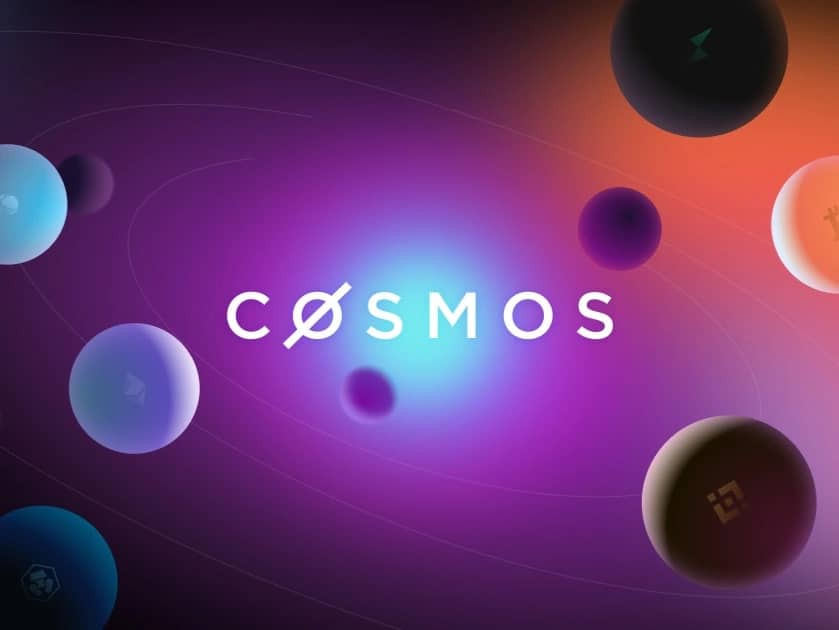Cosmos (ATOM)
**코스모스(ATOM)**는 Tendermint가 개발한 오픈소스 인터체인 네트워크입니다. '존(zone)'이라고 불리는 여러 블록체인이 Atom 토큰으로 구동되는 코스모스 허브(Cosmos Hub)를 통해 통신하고 데이터를 교환할 수 있도록 합니다. 코스모스의 최종 목표는 "블록체인 인터넷", 즉 분산 방식으로 서로 통신할 수 있는 블록체인 네트워크를 구축하는 것입니다. [5]
개요
역사
2014년, Jae Kwon은 코스모스 생태계의 창립 팀인 Tendermint를 설립하여 비잔틴 장애 허용(BFT)를 지분 증명(PoS) 환경에 적용하는 선구적인 역할을 했습니다. 이 프로젝트는 작업 증명(PoW)과 관련된 속도, 확장성 및 환경 문제를 해결하는 것을 목표로 했습니다. 이후 Ethan Buchman이 프로젝트에 합류하여 코스모스 소프트웨어 개발 키트(SDK)를 개발하여 블록체인 개발의 진입 장벽을 낮추고 서로 통신할 수 있는 개별 블록체인의 분산 네트워크를 구축했습니다. 코스모스는 주권, 확장성 및 지속 가능성 문제를 해결하고 레이어 1 블록체인을 연결하기 위한 상호 운용성 솔루션을 제공하는 것을 목표로 합니다. [1][2][3]
2016년, 첫 번째 코스모스 백서가 발표되었고, 그 이듬해 약 1,680만 달러의 자금을 조달했습니다. 코스모스 네트워크 아키텍처가 구축되었고 초기 프로토타입이 개발되었습니다. 2018년에는 인터블록체인 통신(IBC)이 도입되었으며, 그 이후로 코스모스 SDK를 활용하는 프로젝트들이 증가하면서 네트워크는 꾸준히 성장하고 있습니다. [3]
2022년 4월 13일, 코스모스 네트워크 업그레이드인 허브 세타(Hub Theta)가 출시되었습니다. 이 업그레이드는 인터체인 계정을 도입하여 사용자가 한 블록체인에서 실행되는 애플리케이션이 다른 블록체인에서 실행되도록 허용할 수 있도록 합니다. 또한, 사용자가 단일 작업으로 트랜잭션을 완료할 수 있도록 하는 Cosmos SDK 및 IBC의 업데이트된 버전도 포함되어 있습니다. [4]
아키텍처
코스모스 네트워크는 애플리케이션 계층, 합의 계층 및 네트워킹 계층의 세 가지 계층으로 구성됩니다. 코스모스는 합의 및 네트워킹 계층에 Tendermint BFT를 통합하고 애플리케이션 계층에서 도구로 Cosmos SDK를 활용합니다. 이 네트워크는 오픈소스 도구를 사용하여 이러한 계층을 연결하고 dApp 개발을 위한 안전한 환경을 제공합니다. [5]
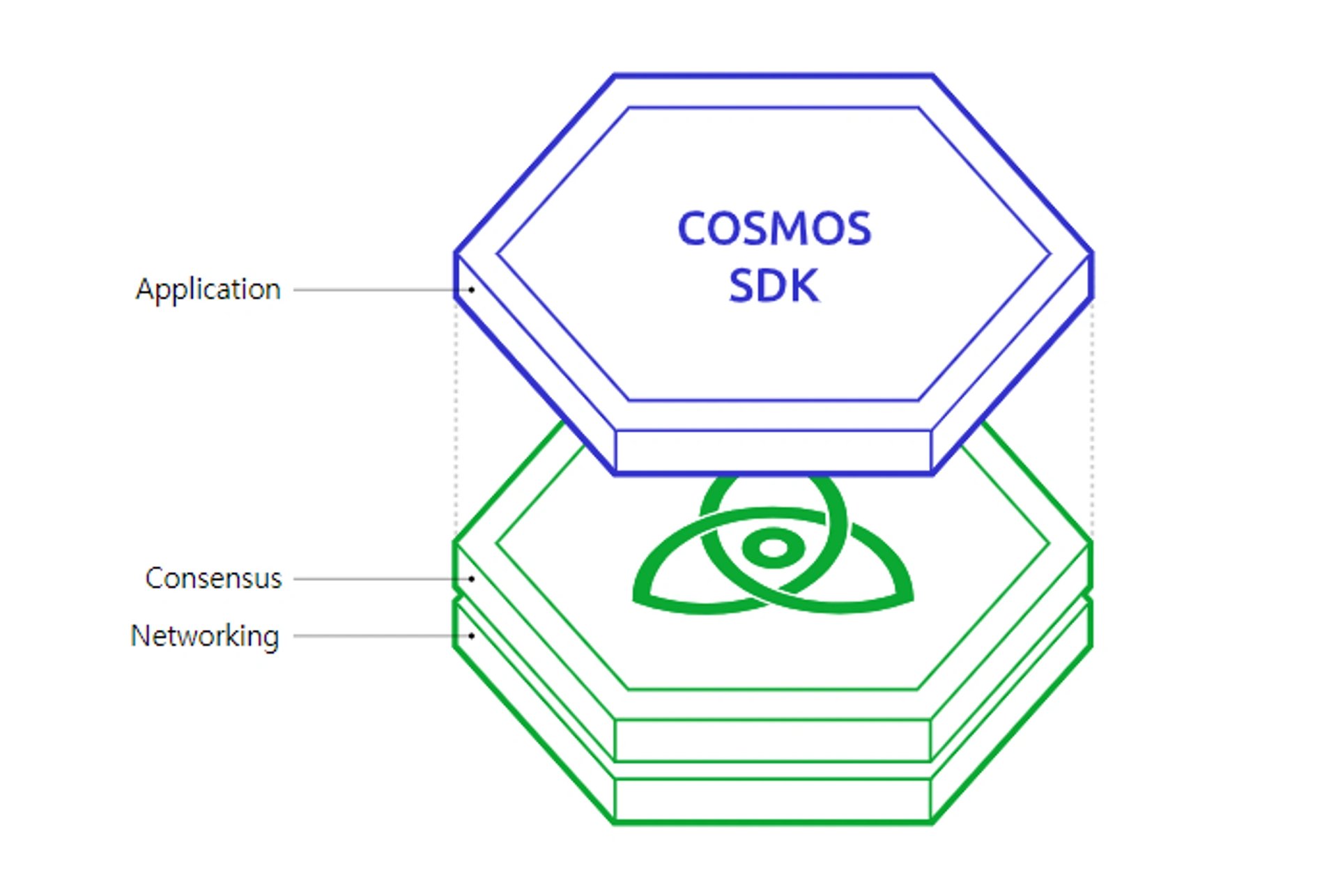
Tendermint 비잔틴 장애 허용(BFT)
Cosmos SDK 도구는 기본적으로 네트워킹 및 합의 계층이 단일 일반 엔진으로 패키징되어 개발자가 처음부터 코드를 작성하지 않고도 블록체인을 구축할 수 있도록 하는 지분 증명 합의 프로토콜인 Tendermint BFT를 사용합니다. [2] 애플리케이션 블록체인 인터페이스 프로토콜을 사용하여 애플리케이션에 연결하고, 트랜잭션을 검증하고, 블록을 실행합니다.
Tendermint BFT는 애플리케이션 블록체인 인터페이스(ABCI)라는 소켓 프로토콜을 통해 애플리케이션에 연결되며, 모든 프로그래밍 언어를 사용할 수 있으므로 개발자는 애플리케이션 구축에만 집중할 수 있습니다. [6]
Tendermint에서 노드는 음수가 아닌 양의 투표 권한을 가질 수 있습니다. 후자의 경우, 이러한 노드를 검증자라고 하며 다음 블록에 대한 투표를 통해 합의 프로토콜에 참여할 수 있습니다. 검증자의 투표 권한은 생성 시 결정되거나 이후 변경될 수 있습니다. [6]
이 프로토콜은 공개 키로 식별되는 검증자 집합을 필요로 하며, 각 블록에 대한 합의에 투표하는 것을 목표로 합니다. 라운드의 제안자는 투표 권한에 비례하여 선택됩니다. [6]
Cosmos SDK
Cosmos SDK는 Tendermint BFT 위에 애플리케이션을 구축하는 것을 용이하게 하는 일반적인 프레임워크입니다. 모듈성과 기능 기반 보안의 원칙을 기반으로 합니다.
Cosmos SDK는 개발자가 dApp 구축에 원하는 언어를 자유롭게 사용할 수 있도록 합니다. 이러한 옵션 중 CosmWasm은 WebAssembly 바이트 코드를 실행할 수 있는 모듈입니다.
코스모스 허브
코스모스 허브는 코스모스 생태계의 중앙 블록체인입니다. 토큰이 보관되는 다중 자산 분산 원장을 제공합니다. 토큰은 "코인 패킷"이라는 특수 IBC 패킷으로 한 존에서 다른 존으로 이동하며, 트랜잭션은 발신자, 허브 및 수신자 블록체인에 의해 실행됩니다. [6]
인터블록체인 통신(IBC)
IBC는 이기종 체인 간의 메시지 전송 및 데이터 교환을 가능하게 하고 코스모스 허브에 연결하는 프로토콜입니다.
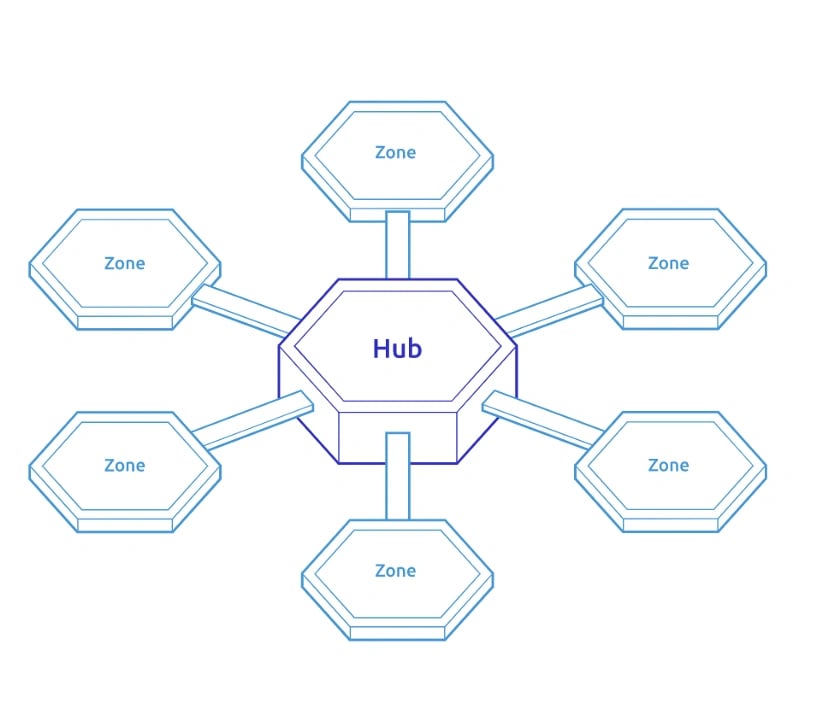
ATOM
ATOM은 코스모스 허브에서 사용되는 주요 토큰입니다. 보유자는 블록체인의 보안 및 거버넌스에 기여하는 검증자에게 ATOM을 위임할 수 있으며, 그 대가로 지분 증명을 통해 ATOM을 보상으로 받을 수 있습니다.
토큰 경제
ATOM의 총 공급량은 2억 6,090만 6,513개입니다. 채굴되는 것이 아니라 스테이킹을 통해 얻습니다. 2017년에는 두 차례의 사모 판매와 한 차례의 공개 판매가 이루어져 총 1,600만 달러를 조달했습니다. 토큰 분배의 80%는 투자자에게 할당되었고, 나머지는 All In Bits와 Interchain Foundation에 분배되었습니다. [7]
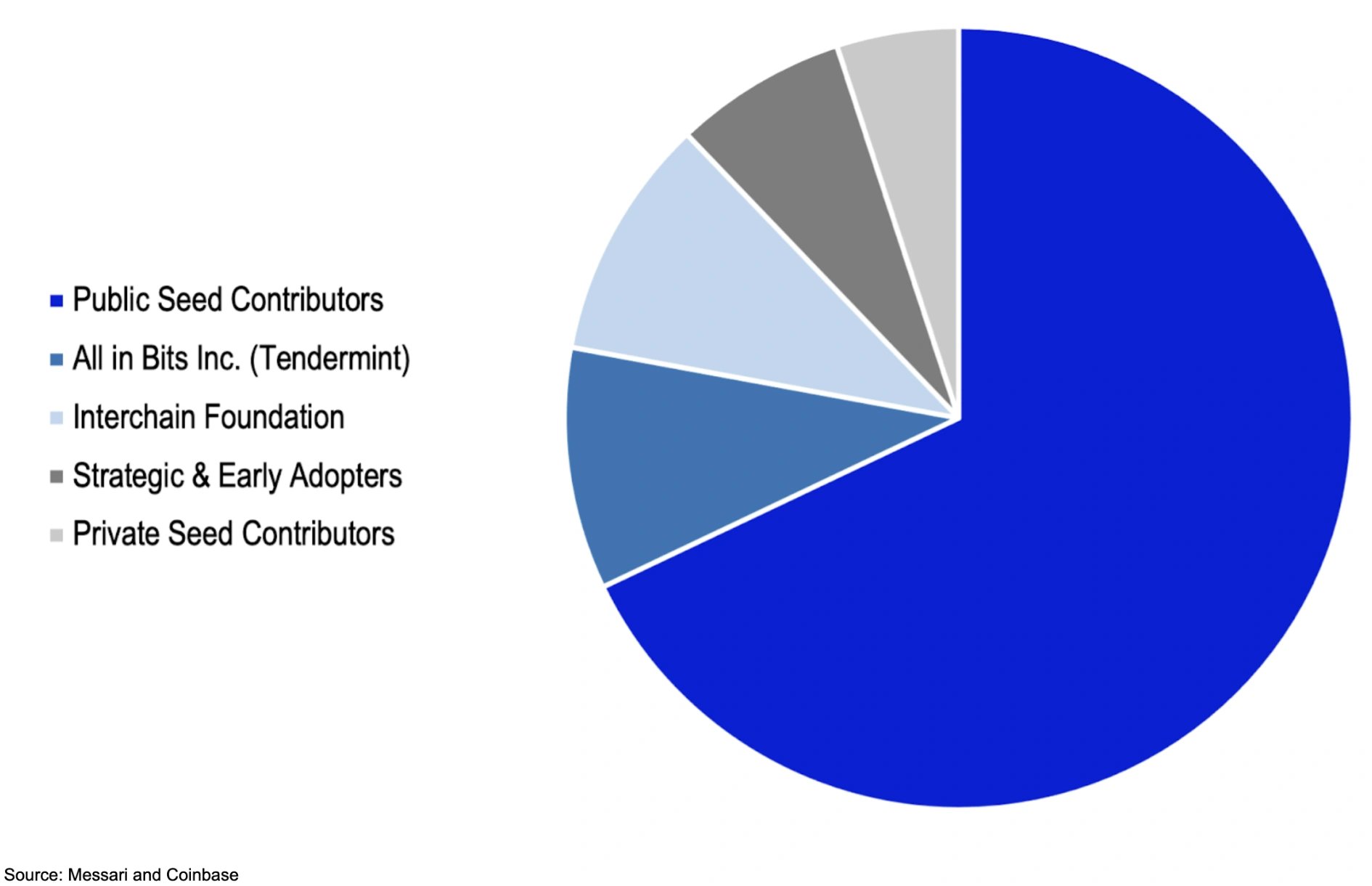
목표 스테이킹 비율은 총 토큰 공급량의 3분의 2입니다. 더 많은 양의 ATOM이 스테이킹되는 경우, 유동성 확보를 위해 발행량이 그에 따라 감소합니다. 반대로 비율이 예상치보다 낮아지면 비율이 일치할 때까지 발행량이 증가합니다. [8]
수수료
트랜잭션으로 인해 발생하는 모든 수수료는 커뮤니티 풀, 위임자 및 검증자에게 분배되는 배포 모듈로 전송됩니다.
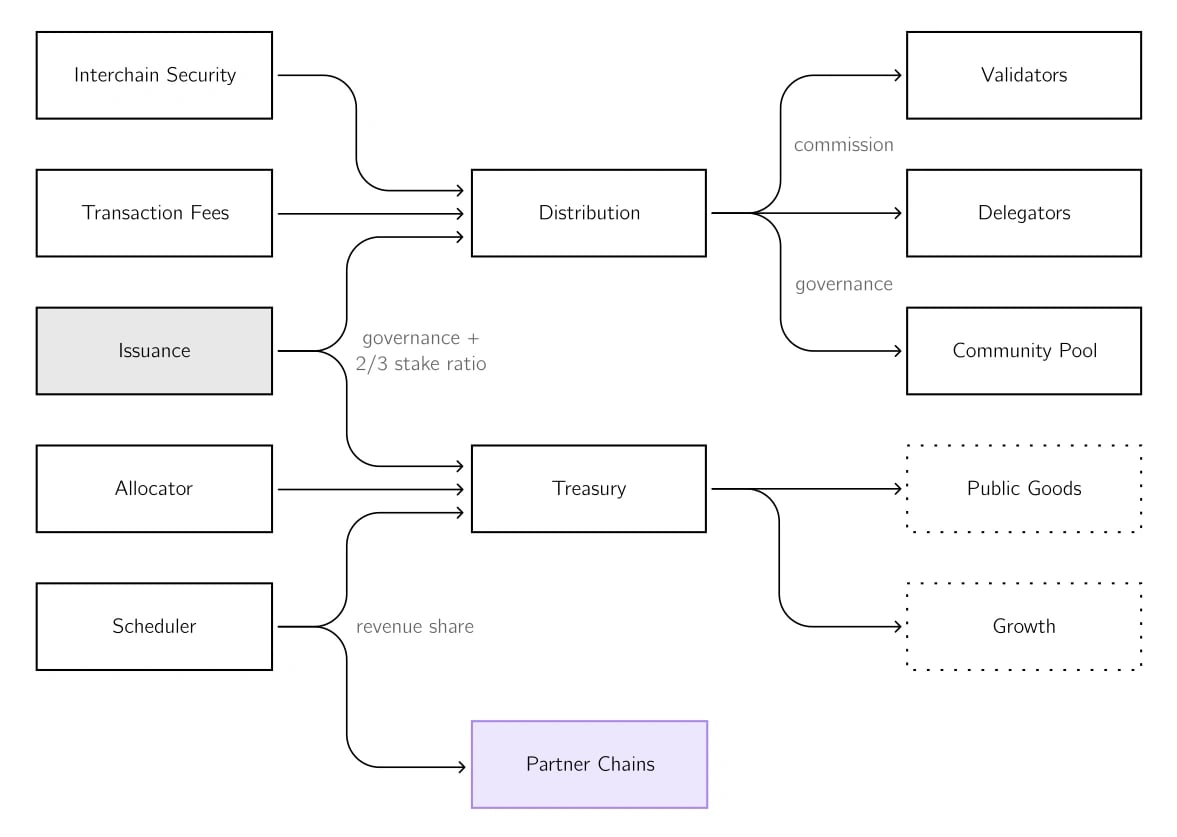
인터체인 보안은 3분의 2 스테이킹 비율을 유지함으로써 검증자와 위임자에게 인센티브를 제공합니다. 허용되는 토큰의 화이트리스트와 해당 최소값을 포함하는 글로벌 수수료 모델도 구현될 것입니다. 이 구조는 궁극적으로 네트워크 사용 수요에 따라 자동으로 조정되는 단일 ATOM 최저 수수료로 전환될 것입니다. [8]
